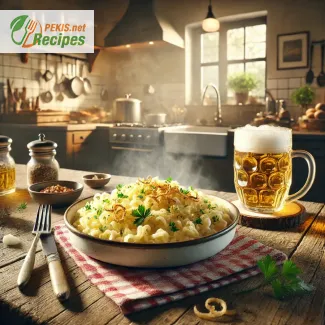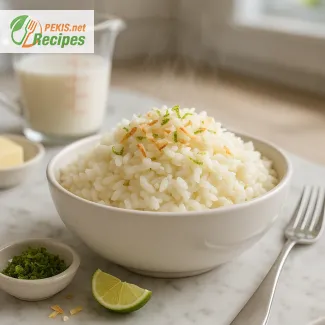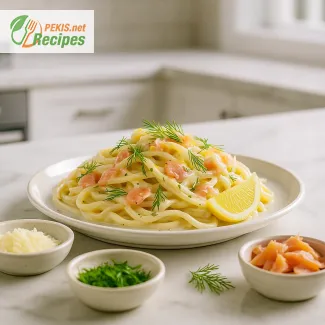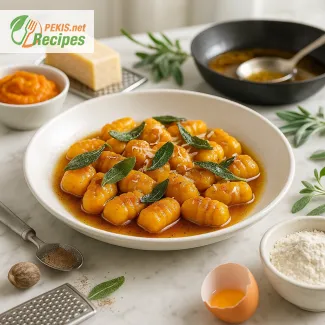
Discover the Authentic Taste of German Spaetzle
A Delightful German Pasta with a Rich Heritage
When it comes to traditional German cuisine, few dishes hold the same comforting appeal as Spaetzle. This soft egg noodle, often described as a cross between pasta and dumplings, is a staple in Bavarian and Swabian kitchens, where it serves as the perfect side dish or even a hearty main course. Whether you’re pairing it with a rich cheese sauce, meaty gravy, or sautéed onions, Spaetzle is a dish that brings warmth to any table.
The Origin of Spaetzle
Spaetzle has deep historical roots in southern Germany, particularly in the Swabian region, where it has been enjoyed for centuries. The name "Spaetzle" originates from the German word "Spatz," meaning "little sparrow," referencing the dish’s irregular shape. Traditionally, this dish was made by hand, using a wooden board and a knife to scrape thin strands of dough into boiling water. Today, modern tools like Spaetzle makers and presses have simplified the process, making it easier than ever to prepare this German favorite at home.
What Makes Spaetzle Special?
Unlike regular pasta, Spaetzle is made with a simple egg-based dough, giving it a soft, chewy texture that soaks up sauces beautifully. The dough is thicker and more elastic, allowing it to hold its shape while cooking. The addition of eggs provides a rich, buttery flavor, making it a fantastic pairing for savory gravies, creamy cheese sauces, or even just a hint of butter and herbs.
One of the greatest things about Spaetzle is its versatility. Whether you prefer it as a classic side dish with roast meats or as a main course with caramelized onions and melted cheese, this dish can be adapted to various flavor profiles. It’s also a great choice for vegetarians, as it can be enjoyed with a range of non-meat sauces and toppings.
How to Enjoy Spaetzle Like a True German
In Germany, Spaetzle is often served as an accompaniment to hearty meat dishes like Sauerbraten (pot roast), Goulash, or Jägerschnitzel, where it soaks up the rich sauces and adds a satisfying texture to the meal. One of the most beloved variations of this dish is Käsespätzle – Germany’s take on mac and cheese, where the noodles are layered with melted cheese and crispy fried onions.
Beyond its traditional pairings, Spaetzle can also be enjoyed as a standalone dish, simply tossed in butter, fresh herbs, and a touch of salt and pepper. For a more indulgent version, try adding grated nutmeg or a splash of cream to elevate the flavor profile.
Tips for Perfect Homemade Spaetzle
Making authentic German Spaetzle at home is easier than you might think. The key to achieving the perfect texture lies in the dough consistency and the cooking method. Here are some tips to help you master this classic dish:
- Use fresh eggs – They give the dough its signature elasticity and rich flavor.
- Don't overwork the dough – Mixing too much can make the noodles dense instead of light and tender.
- Let the dough rest – Allowing the batter to sit for 10-15 minutes ensures a better texture.
- Use a Spaetzle maker – If you don’t have one, a colander or a slotted spoon can work in a pinch.
- Cook in batches – To avoid overcrowding the pot, boil small amounts at a time.
- Sauté for extra flavor – After boiling, toss the noodles in butter for a golden, crispy finish.
A Dish That Brings People Together
In Germany, Spaetzle is more than just a dish—it’s a tradition passed down through generations. Whether enjoyed during family gatherings, festive celebrations, or as part of a cozy homemade meal, it represents comfort, warmth, and togetherness. With its simple ingredients and easy preparation, it’s a dish that anyone can recreate, bringing a taste of Germany to their kitchen.
If you’re looking to explore classic German flavors, Spaetzle is an excellent place to start. Once you master the basic recipe, the possibilities are endless. From cheesy variations to herb-infused creations, this dish offers something for everyone. So, grab your ingredients, heat up the pot, and get ready to enjoy a true taste of Germany with every bite!
- In a large mixing bowl, combine flour and salt.
- Crack the eggs into the bowl and add milk and water.
- Using a wooden spoon or hand mixer, mix the ingredients until a smooth, slightly elastic dough forms.
- Let the dough rest for about 10 minutes.
- Bring a large pot of salted water to a rolling boil.
- Using a Spaetzle maker, press the dough directly into the boiling water. If a Spaetzle maker is unavailable, use a colander with large holes or a slotted spoon.
- Boil the Spaetzle for about 2-3 minutes, or until they float to the surface.
- Use a slotted spoon to remove the cooked Spaetzle and place them in a bowl.
- Melt butter in a pan over medium heat and toss the Spaetzle to coat them evenly.
- Serve warm as a side dish or as a base for other toppings like cheese, gravy, or sautéed onions.
Enhancing the Classic German Spaetzle
Small Changes for a Big Flavor Boost
Traditional German Spaetzle is already a beloved dish, but with a few thoughtful adjustments, you can elevate its taste, texture, and nutritional value. Whether you want a richer, more delicate flavor, a lighter, healthier version, or simply a foolproof method to get perfect results every time, there are several ways to refine and improve this classic recipe.
Adjusting the Dough for a Better Texture
One of the key factors that define good Spaetzle is its consistency. The dough should be elastic but not too stiff, ensuring soft yet chewy noodles. Here’s how you can fine-tune it:
- More eggs for richness – If you prefer a softer, more delicate texture, adding an extra egg yolk will enhance the richness and give the noodles a silkier bite.
- Carbonated water for lightness – Replacing some or all of the plain water with sparkling water makes the dough fluffier and airier, leading to lighter, more delicate noodles.
- Adding a bit of oil – A teaspoon of olive oil or melted butter in the dough can help create a smoother consistency, making it easier to work with.
Ingredient Substitutions for a Healthier Twist
If you’re looking for a healthier version of Spaetzle, consider alternative ingredients that boost nutrition without compromising flavor:
- Whole wheat flour – Substituting up to 50% of all-purpose flour with whole wheat flour adds fiber and a nutty depth to the noodles. Too much, however, can make them too dense.
- Spelt or buckwheat flour – For a more rustic, hearty flavor, try using spelt or buckwheat flour, which also makes the dish easier to digest.
- Dairy-free option – If you’re avoiding dairy, swap the milk for almond, oat, or soy milk, which still provide a creamy texture while keeping the dish lactose-free.
- Gluten-free variation – Use a gluten-free flour blend with xanthan gum to help mimic the elasticity of traditional wheat flour.
Enhancing the Flavor with Herbs and Spices
While classic Spaetzle dough is mildly flavored, small additions can create a more aromatic and flavorful dish:
- Nutmeg – A pinch of freshly grated nutmeg enhances the noodles' earthy and warm taste.
- Garlic or onion powder – Adding a small amount of either infuses subtle depth, complementing creamy sauces or meaty dishes.
- Fresh herbs – Finely chopped chives, parsley, or thyme bring brightness and freshness to the dough.
Cooking Techniques to Improve the Final Dish
Even with the best ingredients, poor technique can ruin homemade Spaetzle. Follow these essential tips for perfect results:
- Resting the dough – Letting the dough rest for 10-15 minutes allows the flour to fully hydrate, improving texture.
- Boiling water temperature – The water should be rapidly boiling when you drop the dough in; otherwise, the Spaetzle may become gummy instead of firm and tender.
- Cooking in small batches – Overcrowding the pot can cause the noodles to stick together. Boil them in smaller portions for even cooking.
- Shocking in cold water (optional) – If you’re not serving Spaetzle immediately, rinse them briefly under cold water to stop the cooking process and prevent them from becoming mushy.
- Sautéing for extra texture – After boiling, tossing the noodles in butter and a hot pan adds a delicious golden crust and prevents sticking.
Common Mistakes and How to Avoid Them
Even experienced cooks can run into problems when making Spaetzle. Here are some frequent mistakes and how to prevent them:
- Dough too thick or too runny – A proper Spaetzle dough should be slightly elastic and sticky, not too stiff or watery. Adjust by adding a bit of flour or liquid as needed.
- Using the wrong tool – A Spaetzle maker ensures the best results, but if unavailable, use a large-holed colander or a slotted spoon for even shaping.
- Letting the dough dry out – If not cooked immediately, keep the dough covered with a damp cloth to prevent drying.
- Overcooking the noodles – Spaetzle cooks quickly; as soon as they float to the surface, they should be removed to avoid becoming too soft and mushy.
Creative Ways to Serve Spaetzle
Spaetzle is incredibly versatile, making it the perfect base for many flavorful variations. Try these ideas for a new twist on the classic dish:
- Käsespätzle (Cheese Spaetzle) – Layer the Spaetzle with grated Emmental or Gruyère cheese, bake it, and top with crispy fried onions for a German-style mac and cheese.
- Herb-infused Spaetzle – Mix fresh basil, chives, or rosemary into the dough for a fragrant, fresh taste.
- Mushroom Spaetzle – Sauté Spaetzle with butter, garlic, and wild mushrooms, finishing with parmesan cheese for a rich, umami-packed meal.
- Spicy Spaetzle – Add a pinch of chili flakes or a spoonful of mustard to the dough for a mild heat kick.
Why Homemade Spaetzle is Superior to Store-Bought
While pre-packaged Spaetzle can be a convenient option, making them from scratch offers several advantages:
- Better texture – Freshly made Spaetzle have a softer, more delicate chew compared to the firmer, often rubbery store-bought versions.
- Customizable flavors – Homemade allows you to adjust seasonings, herbs, and ingredients to your preference.
- Healthier alternative – Many packaged Spaetzle contain preservatives and artificial additives, whereas homemade versions are free from unnecessary chemicals.
- More cost-effective – Making Spaetzle at home is usually cheaper, especially when cooking for larger groups.
The Final Touch
By making small modifications to the classic recipe, you can enhance the flavor, texture, and nutrition of homemade Spaetzle. Whether you experiment with flours, add extra seasonings, or improve cooking techniques, these small changes make a big difference. The beauty of Spaetzle lies in its simplicity and adaptability, making it an endlessly customizable dish that can fit any taste or dietary preference. Try these expert tips and discover just how much better homemade Spaetzle can be!
- Contains eggs, gluten (wheat flour), and dairy (milk, butter).
Substitutions for Allergens and Gluten-Free Version:
- Gluten-free alternative: Replace all-purpose flour with a gluten-free flour blend with xanthan gum for elasticity.
- Dairy-free alternative: Use plant-based milk (such as almond or oat milk) and dairy-free butter.
- Egg-free alternative: Substitute eggs with 60 ml (¼ cup) of applesauce or 1 tbsp of flaxseed mixed with 3 tbsp of water per egg.
- Calcium: 50 mg – Supports strong bones and teeth.
- Iron: 2 mg – Essential for oxygen transport in the blood.
- Magnesium: 15 mg – Helps muscle function and energy production.
- Phosphorus: 80 mg – Supports metabolism and bone health.
- Potassium: 100 mg – Important for nerve function and fluid balance.
- Vitamin A: 200 IU – Essential for vision and immune function.
- Vitamin B2 (Riboflavin): 0.2 mg – Supports energy metabolism and cell function.
- Vitamin B6: 0.1 mg – Helps brain development and function.
- Beta-carotene: 50 mcg – Supports eye health and immune function.
- Lutein & Zeaxanthin: 30 mcg – Protects against eye strain and macular degeneration.
- Vitamin E: 0.5 mg – Helps protect cells from oxidative stress.
- Selenium: 2 mcg – Supports immune function and DNA repair.





